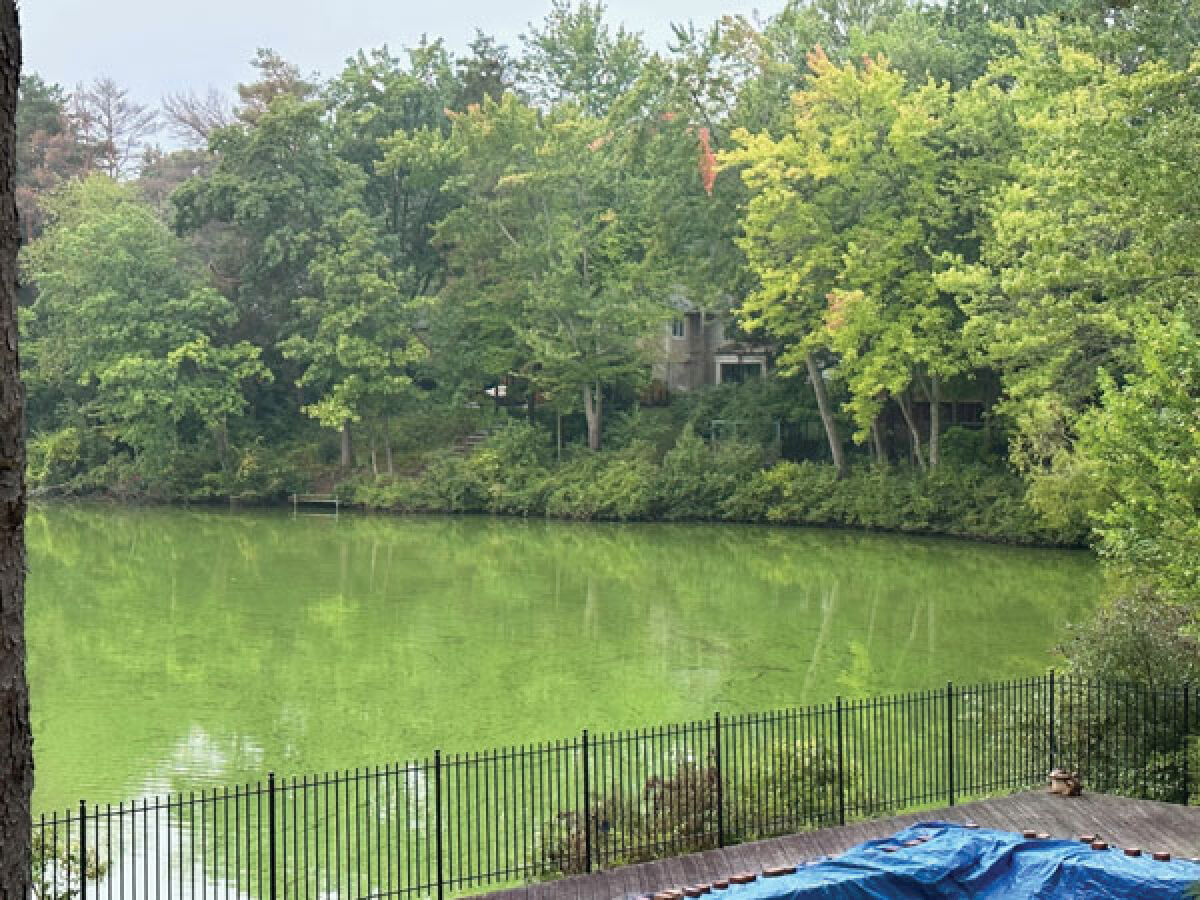WEST BLOOMFIELD — The Michigan Department of Natural Resources recently sent out a warning to residents about harmful algal blooms, also known as HABs, that can form on lakes, rivers and ponds.
HABs form due to rapid growth of cyanobacteria, also known as blue-green algae.
“Cyanobacteria are naturally present in lakes, rivers and ponds; unfortunately, some cyanobacteria produce toxins, called cyanotoxins, that can be present in blooms at levels that are harmful to people and animals,” the release states. “Last year, HABs were reported in 80 bodies of water in 38 Michigan counties, and their frequency and geographic distribution are increasing across the state.”
According to the release, to strengthen the HAB response capacity, nearly a dozen local health departments are part of a Michigan Department of Health and Human Services testing project to do site visits, collect samples, test them for cyanotoxins and send data and samples to the MDHHS.
The blooms typically occur from May through October, most often in August and September, and can last for days to weeks. They can change in size, location and toxicity over time.
Sally Wenczel is part of West Bloomfield’s Environmental Commission. She is also the treasurer and lake health committee chair for the West Bloomfield Lake Community Association.
Wenczel said that West Bloomfield Lake is “right in my backyard.” From her perspective, the best way to avoid HABs is to stay away from the water.
“You can’t kayak anymore. You can’t stick your feet in the water,” Wenczel said. “Don’t let your pets drink from it. You just have to stay away from the lake, and it’s not like one little spot on the lake; it’s, like, all across the whole lake. The whole lake is green.”
Wenczel shared the potential effects of HABs.
“It produces a toxin, and that toxin can cause, in humans, stomach pain, diarrhea, vomiting, weakness, numbness, headaches, dizziness, difficulty breathing, and in large amounts, it can actually harm your liver and kidneys,” she said. “So people who are swimming in this water, recreating in the water — that’s why it’s advised to stay away from the water.”
Wenczel is also a commissioner for the West Bloomfield Parks and Recreation Commission, although she wanted to make it clear that she is speaking on behalf of herself as a resident and for her homeowners association.
According to Wenczel, a researcher from the University of Miami said that it appears airborne bacteria can travel an extended distance from algae blooms.
“This is freaking me out, because I’m living right next to this stuff, and so are 177 households in my neighborhood and the greater community around that,” she said. “So, what are we really dealing with here? Is it enough to say, ‘stay out of the water?’ … I have little kids, I have pets and I’ve been living on this lake for seven years, so what are the long-term health effects for me and my family?”
John Matousek is an aquatic biologist with the Michigan Department of Environment, Great Lakes, and Energy, also known as EGLE. He discussed the possibility of bacteria traveling via air.
“There has been some information out there that it can become aerosolized, the toxins can. To my knowledge, it’s not far-reaching,” Matousek said. “Typically, where you run into issues like that is if you were skiing through it or jet-skiing through, like, an active bloom. Those toxins can become aerosolized and individuals recreating in that direct vicinity can have symptoms like nausea or, more likely, allergy symptoms — runny eyes, itchy eyes, dermal issues, stuff like that.”
Dermal issues pertain to skin and can cause problems such as hives and skin rashes.
Matousek said that there are different types of toxins.
“There are some that affect the liver, there’s some that affect the nervous system, but the most common symptoms in reports that we get are like dermal issues,” he said. “It can be vomiting, it can be gastrointestinal issues, stuff like that. That’s the most common reports.”
Wenczel has heard speakers offering a potential solution to the problem, and some of what she heard has resonated with her.
“They were talking about natural, organic ways to heal a lake, to clean water … using bio enzymes and oxygenation,” she said.
Oxygenation is the process of adding oxygen to something.
Matousek was asked about bio enzymes and oxygenation as potential solutions for helping to clean water.
“I’m not overly familiar with anything like that, so I can’t really speak to whether or not that would be a good solution,” he said. “There’s no real great solution that I know of right now, other than trying to reduce nutrients in the water. Lake associations do a fair amount of spraying with treatment — chemicals.”
Matousek shared his perspective as to the best way to prevent HABs.
“Nutrient reduction is the best way to do it,” he said. “Unfortunately, it’s not a short-term solution. Stuff that landowners can do is don’t fertilize your lawn right up to the lake edge; clean up after your pets to reduce nutrients that might flow off of your lawn and into the lake; use phosphorus-free detergents, soaps and things like that; try to make sure that your septic system, if you’re on septic, is functioning properly and not leaking.”
According to Matousek, a significant amount of testing is done in the state, with the state primarily relying on reports from the public.
“We ask people to send reports and photos,” he said. “Typically, our first effort is to take a look at the photos and determine whether or not it is a cyanobacterial bloom, which are the ones that can potentially produce toxins, and if it is, we will arrange some testing.”
Residents can send reports and photos to algaebloom@michigan.gov.
Wenczel said that West Bloomfield Lake is on life support.
“I believe we found a solution,” she said. “The holdup is the state of Michigan, EGLE. … They don’t test it anymore. … They just put up signs that say, ‘Stay out of the water.’”
As far as Wenczel is concerned, HABs should be treated as a human health crisis.
To clean the lake, she estimated that the first year of treatment would cost more than $45,000.
“And then every year thereafter, you have to have a full year, I think it’s on a monthly basis — you put the bio enzymes in at each oxygenation station, so they’re located in various spots around the lake at the lake bottom,” Wenczel said. “And that is $16,000 a year for the bio enzymes.”
Wenczel shared where she thinks the funds to accomplish that should come from.
“Grant money might not even cover it. It should be disaster funding,” she said. “We don’t have unlimited funds to do this massive cleanup project. We need help from the state. This should be treated as an emergency.”
Wenczel added that the state governs the water and “they should be protecting it.”
From Matousek’s perspective, when it comes to a long-term solution, there are no easy answers.
“It’s a really complicated problem, which leads to a complicated solution,” he said. “I think it’s gonna take efforts from all sources — government efforts, as well as private citizens doing what they can to help alleviate the problem.”
According to Matousek, there is a helpful photo guide on the state’s website to identify HABs. For the easiest way to find it, he suggests doing an internet search using the key words “EGLE HABs.”
“If you see something suspicious, feel free to report it,” Matousek said. “If you do see something like that, just avoid it. When we do find toxins, they are typically located within the visible bloom itself. … Being able to recognize a bloom like that and stay away from it until it subsides is kind of the message we try to get out there.”
For Wenczel, ridding herself of the problem isn’t as simple as merely selling her home.
“Nobody told me when I bought the house, and I feel like I’m so close to solving this problem,” she said. “I don’t have it in me to look somebody in the eye and say, ‘Sure, yeah, buy my house, the lake’s great, the neighborhood’s great.’ … I feel so bad for the people that you see moving in. We send out notices right away that say we have harmful algal bloom problems.”
More information on HABs can be found at michigan.gov/habs.
Those who have questions about keeping themselves safe can call (800) 648-6942.
For more information on HABs and pets and livestock, including reporting diseases, call the Michigan Department of Agriculture and Rural Development at (800) 292-3939.
For more information on HABs and the environment, call EGLE at (800) 662-9278.
 Publication select ▼
Publication select ▼























